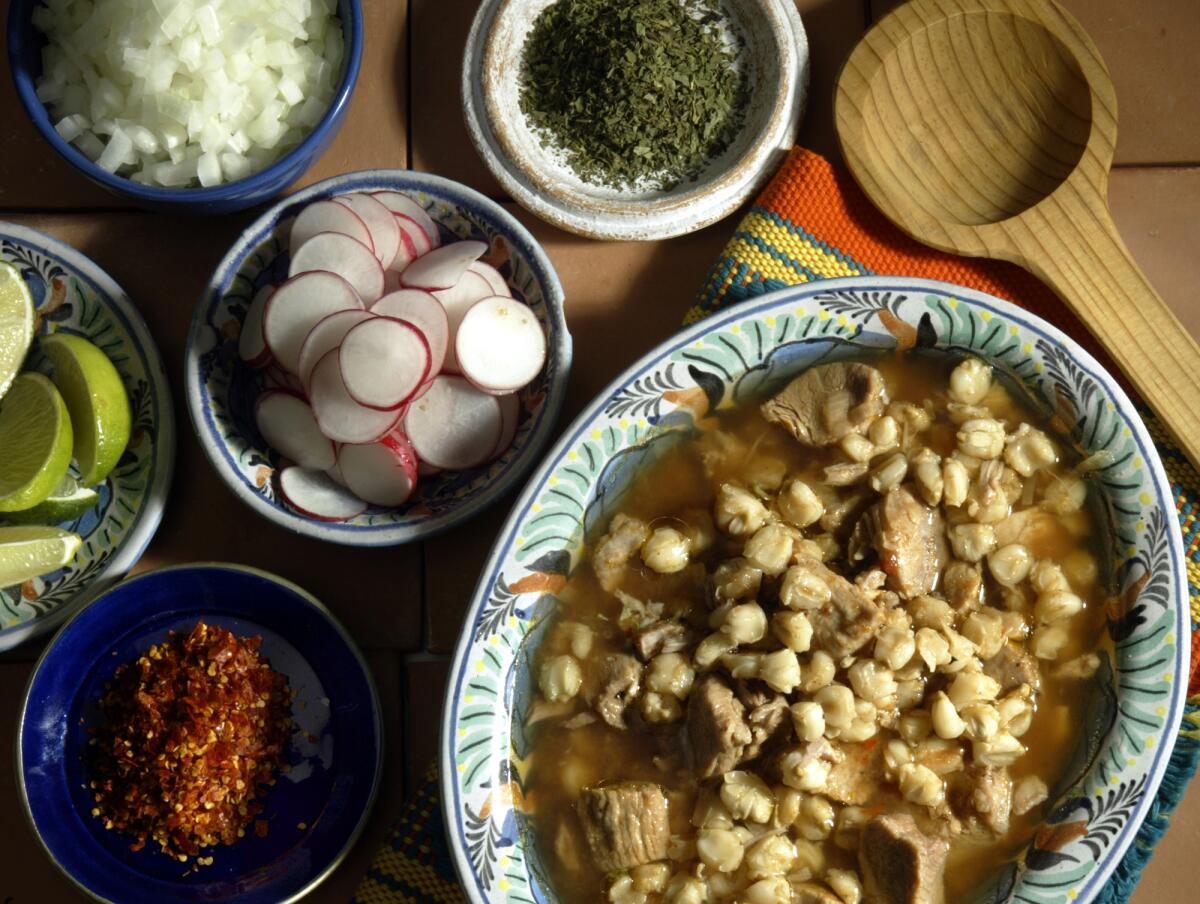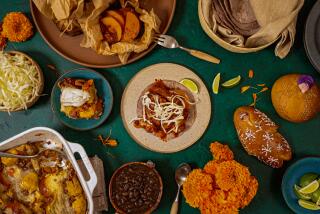Flash of radish, splash of lime
![x77020 –– – 074324.FO.1203.food Posole.Verde Posole Verde with condiments]](https://ca-times.brightspotcdn.com/dims4/default/18a6619/2147483647/strip/true/crop/2000x1546+0+0/resize/1200x928!/quality/75/?url=https%3A%2F%2Fcalifornia-times-brightspot.s3.amazonaws.com%2F81%2F33%2F0691c9584691baa88d2fd9d292d4%2Fhpci5rkf.JPG)
- Share via
POZOLE is the perfect party dish — easy to make, impressively showy and fun to eat -- so it turns up at celebrations in Mexico from Independence Day to birthdays, weddings and baptisms.
And we think this big, soupy bowl of hominy and chiles is a perfect Super Bowl feast: a one-dish meal that you can make in advance, reheat and set out in a pot for people to help themselves.
Pozole is party food because the dish isn’t complete until each diner splashes on more colors and flavors from an array of condiments. A squeeze of lime adds the zing of authority. Dried oregano crumbled into the hot soup sends out an intense herbal aroma. Dried or fresh chiles or a hot chile salsa spice it up. Chopped onion is a must. Shredded cabbage or lettuce give a cool crunch, and sliced radishes add a striking dash of red and white. Crisp, golden-brown tortillas already made into tostada bases are the traditional accompaniment.
What makes pozole distinctive is the main ingredient -- dried corn. But you don’t have to worry about the tedious job of cooking the corn from scratch and removing the hulls to make hominy. All you have to do is go to a tortilleria, or, even easier, any large supermarket that caters to Latinos, and buy a sack of nixtamal.
Nixtamal is dried corn cooked with food-grade lime until it can be hulled. The softened, cooked corn can then be ground into masa for tortillas or tamales. Or it is left whole and cooked further to make pozole.
Some people substitute canned hominy, but why do that when cooking nixtamal is so easy?
You just put the corn in a pot, add water and simmer until the kernels burst forth like flowers. (American-style canned hominy is processed with a different alkali so its flavor is not quite the same. However, Mexican-style canned hominy brands such as Juanita’s and El Mexicano are processed in the traditional manner.)

Supermarkets that stock Latino foods usually carry both canned Mexican-style hominy and fresh nixtamal. Packed in two- and five-pound bags, nixtamal is usually in the refrigerated deli section, along with fresh masa. It also is available at most tortillerias.
As the nixtamal cooks, a warm, earthy aroma envelops the kitchen. If you’ve ever walked past a tortilleria that is open to the street and at peak production, you know the fragrance. So cooking this dish is as pleasurable as eating it.
There’s no single recipe for pozole. What goes into the pot besides corn varies from place to place in Mexico, so there are different versions: green pozole in Colima, red or white pozole in Jalisco, seafood pozole in Veracruz and on the coast of Oaxaca. Pueblo Indians in the United States have their own versions.
Pork is the most popular pozole meat today, although the indigenous inhabitants of Mexico made pozole long before the Spaniards arrived and introduced pigs.
Most Mexican restaurants in Southern California serve red pozole with pork. I never saw green pozole until I took cooking classes in Guanajuato at the Academia Falcon, where I was studying Spanish.
Working in a quaint, tiled kitchen, we blended poblano chiles with cilantro and added that to the corn along with cooked chicken. The flavor is captivating, as appealing as green enchiladas. In the state of Guerrero, green pozole is thicker and contains tomatillos, explained our instructor, Luis Marhuani Marin Reyes.
For red pozole, we colored the broth with cascabel chiles ground with tomatoes, and added lean pork. Meat with bones gives the best flavor, Luis said, and some pozoles are made with cabeza (head) and pig’s feet.
When I tried the recipe at home, I bought pork labeled for pozole from a supermarket in downtown Los Angeles. That meat included pieces on the bone, but the woman behind the counter explained that some cooks add a little boneless pork stew meat, which makes the pozole easier to eat.
Here are the recipes from the classes in Guanajuato.
If you’re having a Super Bowl party, why not serve them both?
*
Pozole verde (green pozole)
Total time: 3 hours, 10 minutes
Servings: 8 to 10
Note: Nixtamal is cooked and softened dried corn. It’s available in the refrigerated deli section of Latino markets and some supermarkets.
1 (2-pound) bag nixtamal
25 cups (6 quarts plus 1 cup) water, divided
6 chicken breast halves,
about 4 pounds
6 1/2 teaspoons salt, divided
1 pound (4
medium)
poblano
chiles
1 bunch
cilantro
2 medium onions, divided
4 cloves garlic, peeled
1 head iceberg lettuce,
shredded
6 serrano chiles, sliced
4 to 6 limes, cut into wedges
1/4 cup or more dried oregano
1 package whole crisp corn
tortillas (used for tostadas)
1. Place the nixtamal in a colander and rinse thoroughly. Pour it into a large Dutch oven or a heavy lidded pot, add 16 cups water and bring to a boil. Boil gently, loosely covered,
2 hours, or until tender. Do not allow the mixture to boil dry. Enough water should remain at the end of the cooking time to keep the nixtamal moist.
2. Meanwhile, wash the chicken. Place it in a heavy lidded pot with 8 cups water and 2 teaspoons salt. Bring it to a boil, reduce the heat, cover and simmer 1 hour. Strain and measure the broth, adding water if necessary to equal 8 cups. Shred the meat, discarding the skin and bones. Set aside the broth and the chicken.
3. When the nixtamal is tender, remove it to a bowl. Wash the pot, then return the cooked nixtamal to the pot.
4. Wash the poblano chiles and discard the stems and seeds. Cut into chunks. Wash the cilantro and cut off the tips of the stems. Place the chiles and cilantro in a blender jar and add 1 cup water. Blend until thoroughly pureed.
5. Slice 1 onion.
6. Add the chile-cilantro puree, the chicken broth, the sliced onion, the garlic cloves and 4 1/2 teaspoons salt to the nixtamal. Stir to combine. Bring to a boil, reduce the heat and simmer, covered, 30 minutes.
7. Add the chicken and cook 15 more minutes.
8. Dice the remaining onion and place it in a small bowl. Arrange the lettuce, serrano chiles, lime wedges and oregano in separate bowls, and the crisp tortillas in a basket or bowl.
9. To serve, ladle the pozole into large soup bowls and add lettuce, chile slices, lime juice and oregano as desired, with tortillas to accompany.
Each serving: 523 calories; 28 grams protein; 88 grams carbohydrates;
13 grams fiber; 8 grams fat; 1 gram saturated fat; 44 mg. cholesterol;
1,608 mg. sodium.
*
Pozole Estilo Jalisco (Jalisco-style pozole)
Total time: 3 hours, 20 minutes plus overnight soaking
Servings: 8 to 10
Note: Nixtamal is cooked and softened dried corn. It’s available in the refrigerated deli section of Latino markets and some supermarkets. Pork for pozole is cut-up pork shoulder, with bones.
12 to 16 dried cascabel chiles
1 tablespoon oil
1 (2-pound) package nixtamal
24 cups (6 quarts) water
3 medium onions, divided
1 head garlic, cloves separated
3 pounds plum tomatoes
3 pounds pork for pozole or pork stew meat
3 tablespoons salt or to taste
1 head iceberg lettuce,
shredded
1 bunch radishes, trimmed
and sliced
1/3 to 1/2 cup dried oregano
Crushed or ground chile
pequin or other hot chile
10 to 12 limes, cut into wedges
1 package whole crisp corn
tortillas (used for tostadas)
1. Cut open the cascabel chiles and remove the seeds. Heat the oil in a small skillet over low heat. Add the chiles and cook, stirring, until fragrant, 3 to 4 minutes. Place in a bowl, cover with water and soak overnight. Before using, drain the chiles, discarding the water; remove the stems and any remaining seeds.
2. Place the nixtamal in a colander and rinse thoroughly. Place in a Dutch oven or heavy lidded pot and add the water. Slice 1 onion and add it to the pot along with the garlic cloves. Bring the mixture to a boil and boil gently, covered, 1 1/2 hours.
3. Meanwhile, place the tomatoes in a pan of boiling water and cook 2 minutes. Drain and allow to cool, then peel. Place the tomatoes and the chiles in a blender and puree. Set aside.
4. Remove the excess fat from the pork. The meat can remain in large chunks. When the nixtamal has boiled 1 1/2 hours, add the pork, the tomato-chile mixture and the salt. Cover and boil gently 1 1/2 hours longer.
5. Chop the 2 remaining onions. Arrange the chopped onions, lettuce, radishes, oregano, ground chile and lime wedges in serving bowls.
6. To serve, ladle the pozole into large soup bowls. Add the garnishes and squeeze in lime juice as desired, with tortillas to accompany.
Each serving: 622 calories; 28 grams protein; 100 grams carbohydrates;
20 grams fiber; 16 grams fat; 4 grams saturated fat; 52 mg. cholesterol; 2,202 mg. sodium.
*
The armchair alternative: takeout pozole
Although pozole is harder to find in Los Angeles than menudo, the popular hangover remedy, we located several places that offer it for takeout. Red pozole with pork, the most readily available, may look fiery but is usually mild, ready to season to taste with hot chiles or a variety of side ingredients.
El Gallito: Most of the eating places in El Mercado de Los Angeles sell pozole on weekends, but El Gallito has it every day. The to-go pozole ($3.95 small, $5.95 large) includes shredded lettuce, onion mixed with cilantro, lime wedges, tostadas and bits of dried red chiles combined with oregano.
El Gallito, 3425 E. 1st St., Los Angeles (inside the market), (323) 266-0127.
Cenaduria La Casita Mexicana: This cafe cooks dried purple corn -- maiz morado -- to make the nixtamal used in its pozole ($4.50 small, $6.50 large), which comes with either pork or chicken. The sides are shredded cabbage, onion, lemon wedges, tostadas and a really spicy red sauce.
Cenaduria La Casita Mexicana, 4030 E. Gage Ave., Bell, (323) 773-1898.
Tamales Liliana’s: Red pozole with very tender pork ($4.50 small, $5 large) is available every day at both branches of Tamales Liliana’s, accompanied by shredded cabbage, lime wedges, radishes and tostadas.
Tamales Liliana’s, 3448 E. 1st St., Los Angeles, (323) 780-0829, and 4619 E. Cesar E. Chavez Ave., East Los Angeles, (323) 780-0989.
Carrillo’s Tortilleria: Carrillo’s Tortilleria & Mexican Delicatessen offers a choice of house-made corn or flour tortillas instead of tostadas with its pozole ($6), as well as shredded cabbage, chopped onion, cilantro, sliced radishes and a lemon wedge.
Carrillo’s Tortilleria & Mexican Delicatessen, 2836 Cochran St., Simi Valley, (805) 522-8939; 19744 Sherman Way, Canoga Park, (818) 887-6118; and 1242 Pico St., San Fernando, (818) 365-1636.
The Talpa: The to-go package of this restaurant’s mild but well-seasoned pozole ($5.45 small, $7.45 large) comes with tortilla chips, shredded cabbage combined with radishes, chopped onion, lemon wedges and pickled jalapenos.
The Talpa, 11751 W. Pico Blvd., West Los Angeles, (310) 478-3353.
-- Barbara Hansen


